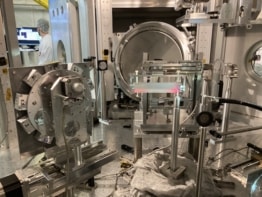
Researchers in China and Spain have succeeded in making a saser – the equivalent of a laser for sound waves – by adding a gain medium to artificial acoustic materials known as sonic crystals. The new saser could have applications in medical ultrasonics and non-destructive materials testing, among other areas.
Gain media (also known as active media) are commonplace in optics and are a crucial part of lasers. However, they have not really been employed for sound waves before, explains Johan Christensen, an expert in acoustic metamaterials at the Universidad Carlos III de Madrid. In a laser, the gain medium typically consists of a material such as a semiconductor, doped crystal or glass surrounded by a highly reflective optical cavity. By stimulating electrons within this medium to release energy due to collisions with photons in the cavity, it is possible to produce a coherent beam of photons all oscillating in unison, at the same frequency.
The new saser uses phonons – sound waves composed of sonic vibrations – rather than photons, and its gain medium consists of carbon nanotube (CNT) films. Here, bursts of heat get converted into sound when an alternating current is applied to the films. This acoustic amplification process generates sound even in the absence of a cavity, and without stimulated emission.
Whispering gallery modes
Together with Xiaojun Liu and Ying Cheng of Nanjing University, Christensen and colleagues constructed their saser out of sonic crystals made from thermoplastic rods arranged in a so-called kagome lattice – a pattern inspired by Japanese basket weaving. The rods, which are made from acrylonitrile butadiene styrene (ABS) enclosed by CNT films, allow the researchers to harness highly confined and amplified sound wave excitations that revolve around the structure’s edge. These topologically protected edge excitations are known as whispering gallery modes and are named after the now-famous phenomenon (first observed by Lord Rayleigh in 1878) of sound waves creeping around the curved gallery of St Paul’s Cathedral in London.
“This method allows for a rather flexible and tuneable approach to making a sonic gain medium that is based on the thermoacoustic effect in which (fluctuating Joule) heat is converted into sound when an alternating current is applied to the CNT film-coated ABS plastic rods,” Cheng explains. “Not only do the topological whispering gallery modes revolve around the enclosed sonic insulator through the complex edge states, they also out-couple and focus sound emission at audible frequencies.”
More concentrated and directed sound scanning
Such a saser could garner interest in medical ultrasonics where the main aim is to target and focus high-intensity sound waves – with little spread – on very small areas, he tells Physics World. Likewise, non-destructive tests for cracks in materials and fatigue could capitalize on the device’s narrow beam of sound, as it would enable far more concentrated and directed sound scanning.

Light waves steer electron beams thanks to whispering gallery effect
The researchers, who report their work in Nature, now plan to modify their topological saser to make it emit at more useful ultrasonic frequencies and not just at low, audible, ones. “This will require shrinking the sonic crystal, but it might also be possible by changing the thermoacoustic gain medium,” Christensen says.



